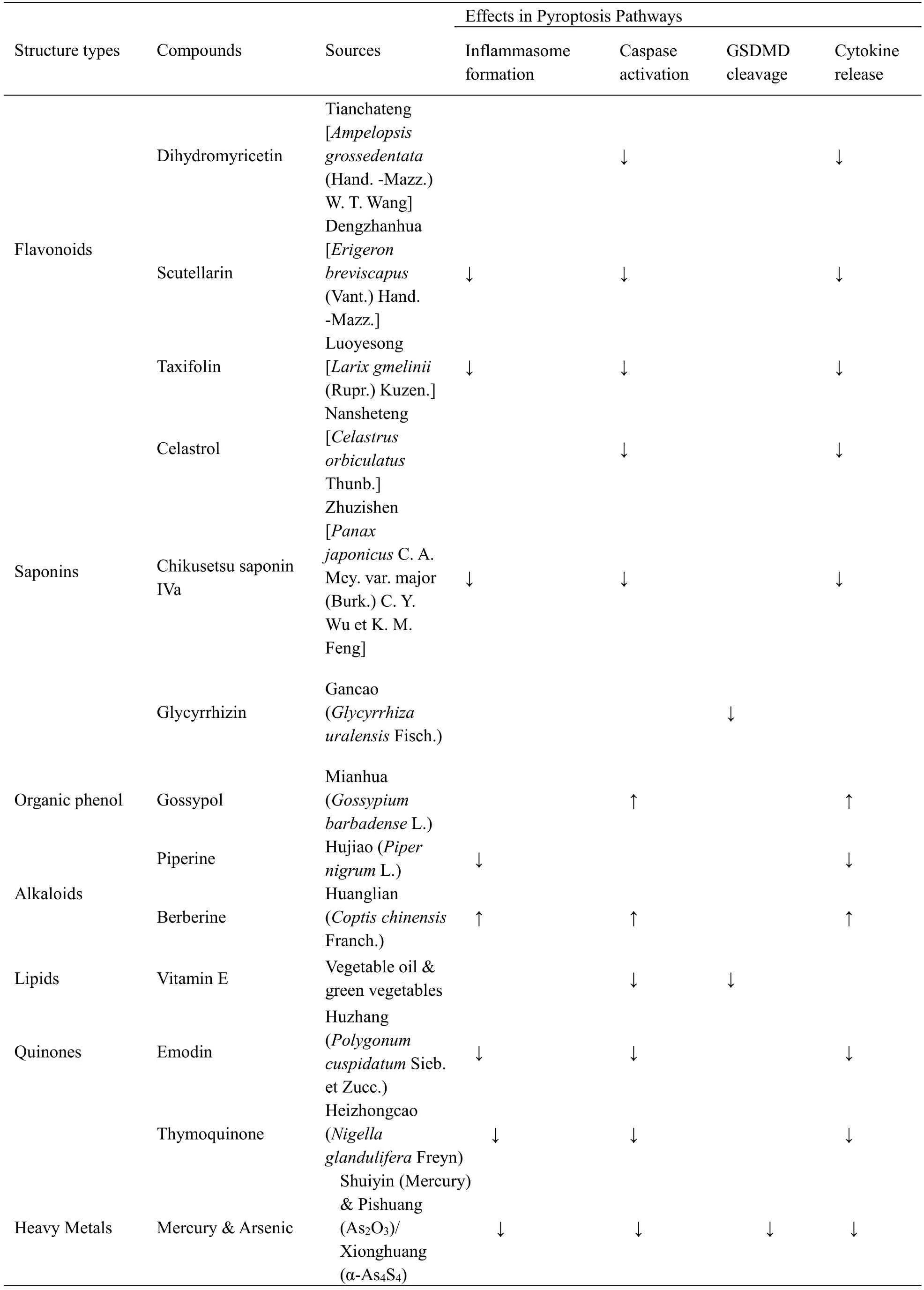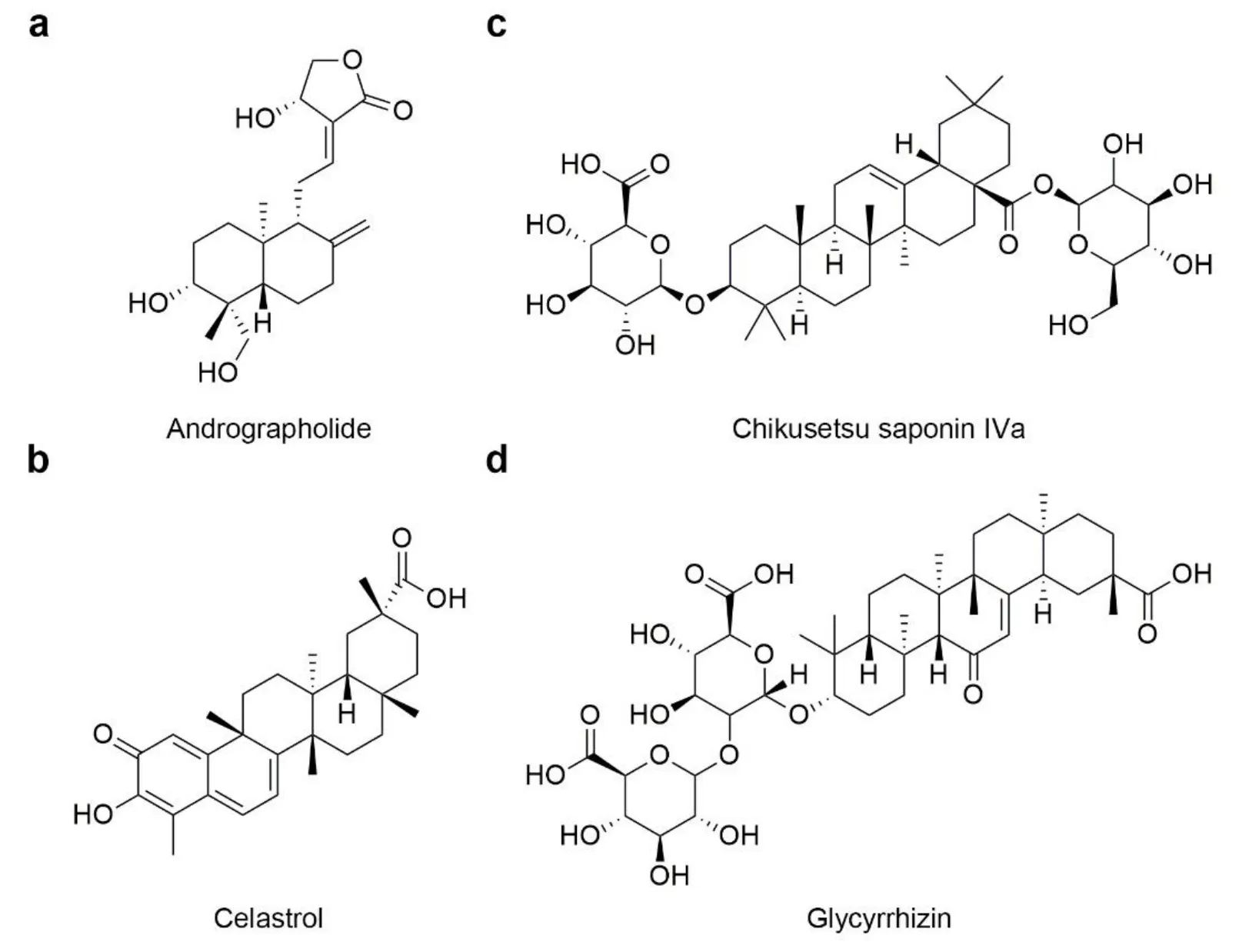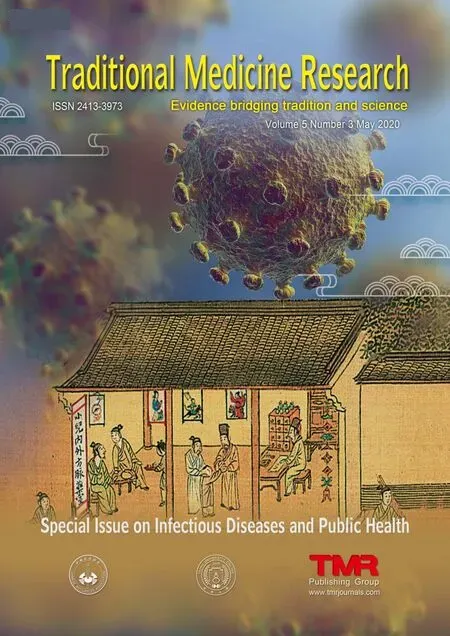The role of natural products in regulating pyroptosis
Yi-Zhen Bai,Ke-Wu Zeng*
1State Key Laboratory of Natural and Biomimetic Drugs, School of Pharmaceutical Sciences, Peking University, Beijing 100191,China.
Abstract
Keywords:Natural products,Pyroptosis,Programmed cell death,Gasdermin-D,Inflammasome.
Background
Pyroptosis was found inSalmonellaandShigellaspecies-infected macrophages and named by Dr.Brad T.Cookson in 2001.Then, numerous researches have been reported on pyroptosis molecular mechanism,shedding light on a new cell death type.Currently,pyroptosis has been considered as programmed cell death in response to infections by intracellular pathogens and plays a crucial role in promoting occurrence and development of multiple human diseases.Unlike apoptosis, pyroptosis is a gasdermin-mediated programmed cell death characterized by cell swelling, lysis,and release of cell contents accompanied by a series of strong inflammatory reactions [1-3].During pyroptosis, a large supramolecular complex termed inflammasome is activated, which in turn activates classical caspase-1 and/or non-classical caspase-4/5/11 signaling pathways.After caspases activation, gasdermin-D (GSDMD) is cleaved to form transmembrane protein polymers,leading to plasma-membrane pores formation for neutralizing cellular ionic gradients and promoting cell swelling as well as osmotic lysis [4, 5].Inflammatory cytokines are also cut and released out of the membrane, triggering a subsequent response [6].Therefore, to deeply explore pyroptosis molecular mechanism will provide new insights and effective therapeutic strategies for various pathological inflammation-associated diseases.
Pyroptosis is widely involved in the development of various human diseases, especially for infectious diseases and autoimmune diseases [7-10].Multiple pathogenic bacteria which are capable of causing infections includingSalmonella typhoid,Streptococcus pneumoniae,Actinobacilluspleuropneumonia,Candida albicansand drug-resistantStaphylococcus aureuscan induce pyroptosis-relevant pathology by activating nucleotide-binding oligomerization domain-like receptor protein (NLRP) 3 inflammatory pathway.Moreover, increasing levels of interleukin(IL)-18 and IL-1β in articular fluid of gout patients have been detected because of uric acid crystallization-induced pyroptosis.Recently, it has been found SIV (Simian immunodeficiency virus) and HIV- infected cells are inclined to activate pyroptosis,further leading to recruitment of various types of immunocytes.Meanwhile, uncontrolled pyroptosis is probably a crucial mechanism accelerating virus invading to immune system.Notably, vitiligo,Addison's disease, inflammatory bowel disease,rheumatoid arthritis and other autoimmune diseases are highly associated with pyroptosis which is mediated by NLRP1 inflammatory pathway.Additionally, the occurrence and development of atherosclerosis,Alzheimer’s disease and amyotrophic lateral sclerosis,lung injury,heart failure,metabolic syndrome and type 2 diabetes mellitus are also accompanied by pyroptosis.
Pyroptosis can be triggered by various endogenous and exogenous risk factors, whose inflammasome pathways can be classified as canonical(caspase-1-dependent) and noncanonical(non-caspase-1-dependent).In classical pathway,caspase-1 precursors are activated by inflammasome.Mature caspase-1 cuts GSDMD to release GSDMD N-terminal with membrane perforation activity.GSDMD N-terminal can interact with cardiac phospholipids and phosphoinositol, then polymerize,anchor and perforate on cell membranes, causing cell swelling, foaming and bursting, eventually leading to cell lysis [11].Noncanonical pathway is initiated by caspase-4/5/11, whose caspase recruitment domain(CARD) can directly recognize and bind to lipopolysaccharide (LPS).LPS-activated caspase-4/5/11 cleaves GSDMD between N-terminal and C-terminal, thereby releasing N-terminal with pore-forming activity [12-15].Recent studies have confirmed that caspase-3, caspase-8 and other members of gasdermin family (such as GSDME) also contribute to some certain processes of pyroptosis[16-23].Further research on pyroptosis molecular mechanisms in various diseases will help deepen our understandings on cell death modes and provide new strategies for prevention and treatment of pyroptosis-associated human diseases.
Natural products are important sources of new drugs with diverse structures and activities.Notably, in recent years, accumulating studies have focused on pyroptosis regulation using natural products as potential candidate drug molecules, indicating that natural products may be widely involved in pyroptosis-associated pathological processes.Therefore, it is a promising direction of natural products in promoting novel agents’ development for pyroptosis-related diseases in the future.The aim of this study is to review the molecular mechanisms and pathways of pyroptosis,and to categorize and conclude research results on the correlation between different natural products and pyroptosis in recent years.
Flavonoids
Dihydromyricetin
Dihydromyricetin (Table 1, Figure 1a) is a dihydroflavonol compound mainly from leaves of Tianchateng[Ampelopsis grossedentata(Hand.-Mazz.)W.T.Wang], the traditional Chinese medicine (TCM)recorded inZhonghua Bencao, a TCM classics.Dihydromyricetin shows versatile biological functions including antioxidant, hepatoprotective,anti-inflammatory and anti-tumor activities.It has already been reported that dihydromyricetin can inhibit pro-inflammatory factor IL-1β release from murine leukemia RAW264.7 cells, which is a crucial cellular event in pyroptosis [24].Moreover, Huet al., 2018 demonstrated that palmitic acid might induce inflammatory programmed death in endothelial cells,which could be effectively suppressed by dihydromyricetin by inactivating caspase-1 signaling pathway, reducing the levels of intracellular reactive oxygen species (ROS) and mitochondrial ROS and activating the NFE2(nuclear factor erythroid 2)related factor 2 signaling pathway [25].Thus, it is speculated that dihydromyricetin may play an important role in endothelial cells pyroptosis induced by palmitic acid.
Scutellarin
Scutellarin (Table 1, Figure 1b) is mainly extracted from Dengzhanhua [Erigeron breviscapus(Vant.)Hand.-Mazz.], the Chinese medicine recorded inZhonghua Bencao,a TCM classics.It is anti-inflammatory and, according to many reports, can reduce cerebral vascular resistance, increase cerebral blood flow, improve cerebral blood circulation and prevent platelet aggregation.Scutellarin is clinically used to treat cerebral vascular diseases after paralysis.Liuet al., 2017 investigated whether scutellarin could affect NLRP3 inflammasome activation in macrophages, and found that scutellarin reduced mature IL-1β release and caspase-1 activation in macrophages.Moreover, scutellarin suppressed pyroptotic cell death through blocking apoptosis-associated speck-like protein containing CARD (ASC) speck formation and oligomerization.In addition, scutellarin has been reported to suppress NLRP3 inflammasome activation by regulating PKA signaling pathway [26].Overall, these observations emphasize a potential therapeutic application of scutellarin in NLRP3-related pyroptosis progress.
Taxifolin
Taxifolin (Table 1, Figure 1c) is a kind of dihydroquercetins from Luoyesong [Larix gmelinii(Rupr.) Kuzen.], which is anti-leukemia and bacteriostatic.Yeet al., 2017 studied on the effect of taxifolin on H2O2-induced pyroptosis in human cardiomyocyte cell line H9C2and found taxifolin effectively improved H9C2morphology.Moreover,mitochondrial membrane potential was markedly decreased in H2O2-treated cells,which was reversed by taxifolin.Furthermore, significant increases of caspase-1 and mRNA of IL-1α,IL-1β, IL-18,absent in melanoma 2 (AIM2), ASC, NLRP3 and NLR family CARD domain-containing protein (NLRC)4 in the H2O2-treated cells were attenuated by taxifolin [27].These findings strongly support that taxifolin can protect H9C2cells against pyroptosis through inhibition of AIM2,NLRP3 and NLRC4 inflammasomes.
Terpenoids
Andrographolide (Figure 2a) is extracted from Chuanxinlian [Andrographis paniculata(Burm.f.)Nees.], the Chinese medicine which is recorded inLingnancaiyaolu(Republic of China, 1933 C.E.), an ancient book of TCM.It belongs to diterpenoid lactones and is usually used for dysentery,leptospirosis,meningitis, pneumonia and upper respiratory tract infection.Liet al., 2018 have revealed that andrographolide can ameliorate intracerebral hemorrhage (ICH)-induced secondary brain injury by inhibiting neuroinflammation.Moreover, ICH-induced microglial activation and neuroinflammation exhibited elevated cytokine levels which can be reversed by andrographolide.Meanwhile, andrographolide is reported to decrease IL-1β and lactate dehydrogenase levels, as well as ICH-induced microglial pyroptosis by suppressing NLRP3 inflammasome assembly and inhibiting NF-κb signaling pathway activation [28].In summary, these studies suggest that andrographolide may play an anti-inflammatory role by inhibiting inflammasomes’ assembly and down-regulating inflammatory factors to mitigate pyroptosis in microglia, which represents a potential candidate for improving brain function.

Figure 1 Chemical structures of Dihydromyricetin,Scutellarin and Taxifolin

Table 1 The classifications,plant origins and functions of compounds in pyroptosis pathway
Saponins
Celastrol
Celastrol (Table 1, Figure 2b), an effective proteasome inhibitor and a pentacyclic triterpenoid, comes from the Chinese medicine Nansheteng (Celastrus orbiculatus Thunb.) according toShengjingtongzhi(Qing dynasty of China,1779 C.E.),an ancient book of TCM.Previous investigations revealed that celastrol showed obvious anti-microbial, anti-inflammatory and immunosuppressive effects.Daiet al., 2019 have reported that celastrol can attenuate inflammatory responses in spinal cord via inhibition of the pyroptosis pathway in microglia.In addition, celastrol observably reduces secretions of IL-1β and IL-18 by suppressing NLRP3 expression and caspase-1 cleavage in LPS/ATP-induced macrophages[29].Furthermore,it is illustrated that celastrol significantly suppresses pyroptosis through inhibition of caspase-1 activation and IL-1β secretion.These inhibitory effects of celastrol have been shown to be achieved, at least in part, achieved by reducing the production of ROS and the activation of NF-κB [30].Taken together, these discoveries reveal that celastrol can alleviate pyroptosis by inhibiting NLRP3-dependent caspase-1 cleavage as well as inflammatory factors’ secretion,suggesting a new anti-inflammation mechanism.
Chikusetsu saponin IVa
As a triterpenoid saponin, chikusetsu saponin IVa(Table 1, Figure 2c) is derived from desiccated rhizome of Zhuzishen[Panax japonicusC.A.Mey.var.Major (Burk.) C.Y.Wu et K.M.Feng], a Chinese medicine recorded inDiannan Bencao(Ming dynasty of China, 1436 C.E.), an ancient book of TCM.It shows effective therapeutic effects to thrombosis and metabolic diseases.Previous studies indicated that total saponins of Panax japonicus rhizoma and major component chikusetsu saponin V exerted anti-inflammatory and anti-oxidative effects.Further studies reveal that chikusetsu saponin V can significantly inhibit high fat diet (HFD)-induced inflammation and lipid homeostasis in adipose tissue,as reflected by decreased mRNA expressions of inflammation-related genes and secretions of cytokines/chemokines.Moreover, chikusetsu saponin Valso suppressesHFD-induced NLRP3 inflammasome component genes and decreases caspase-1 and IL-1β productions.Taken together,these studies uncover that chikusetsu saponin V can control pyroptosis process through inhibiting NLRP3 inflammasome activation,serving as a potential therapeutic agent for inflammation-associated diseases.

Figure 2 Chemical structures of Andrographolide,Celastrol,Chikusetsu saponin Iva and Glycyrrhizin

Figure 3 Chemical structures of Gossypol,Piperine and Berberine

Figure 4 Chemical structures of Vitamin E,Emodin and Thymoquinone

Figure 5 Schematic diagram of pyroptosis pathway and part of the natural products
Glycyrrhizin
Glycyrrhizin (Table 1, Figure 2d), as a kind of triterpenoid saponin, is the most important active ingredient in the Chinese medicine Gancao(Glycyrrhiza uralensis Fisch.) which is recorded inShennongbencaojing(Donghan dynasty of China), an ancient book of TCM.It has been widely studied for its anti-inflammatory, antiviral, anti-cancer and anti-diabetes pharmacological activities.Huaet al.,2019 have studied the molecular mechanism of glycyrrhizin in regulation of hepatic injury induced by ischemia reperfusion(I/R).They found that hepatic I/R could promote pyroptosis of Kupffer cells mediated by GSDMD, while could be delayed by glycyrrhizin through inhibiting high mobility group box-1(HMGB1), thus preventing I/R-induced liver injury[31].Therefore, this study is the first report that glycyrrhizin reduces tissue damage and pyroptosis of Kupffer cells during hepatic ischemia reperfusion injury, suggesting the importance of glycyrrhizin in treatment of ischemia reperfusion.
Organic phenols
Gossypol (GOS) (Table 1, Figure 3a), a polyphenolic compound extracted from seeds of the Chinese medicine Mianhua (Gossypium barbadense L.)recorded byBencaogangmu(Ming dynasty of China,1552-1578 C.E.), an ancient book of TCM, is known to possess various pharmacological activities including anti-cancer and anti-microbial effects.Linet al., 2016 explored the function of GOS on inflammasome activation in mouse peritoneal macrophages, and they clarified that GOS could trigger caspase-1-independent pyroptosis in mouse peritoneal macrophages [32].These data reveal that GOS may induce releases of multiple inflammatory factors and caspase precursors,and thus cause pyroptosis in macrophages through noncanonical inflammasome pathway.
Alkaloids
Piperine
As one of broad-spectrum anticonvulsants isolated from the Chinese medicine Hujiao (Piper nigrum L.)recorded inTangbencao(Tang Dynasty of China, 659 C.E.), an ancient book of TCM, piperine (Table 1,Figure 3b) is reported to target NLRP3 inflammasome which is highly associated with lupus nephritis (LN)development, thus Penget al., 2018 assessed the therapeutic potential of piperine on LN.Piperine significantly ameliorated LN development via inhibition to activation of NLRP3 inflammasomes,production of IL-1β and release of HMGB1 [33].Further research showed that piperine inhibited Adenosine 5’-monophosphate-activated protein kinase(AMPK) activation, and metformin, an AMPK agonist and could bypass piperine to resume NLRP3 inflammasome activation as well as pyroptosis [34].In general, piperine significantly suppresses NLRP3 inflammasome activation, inhibits pro-inflammatory cytokines release, and blocks pyroptosis process in tubular epithelial cells, indicating that it may be an important therapeutic agent in treatment of LN.
Berberine
Berberine (Table 1, Figure 3c) is a quaternary ammonium alkaloid isolated from the Chinese medicine Huanglian (Coptis chinensis Franch.), which is recorded inShennongbencaojing(Donghan dynasty of China), an ancient book of TCM.Berberine can fight against bacterium and has curative effect to gastroenteritis, bacterial dysentery, scarlet fever,tuberculosis, respiratory tract infection and acute tonsillitis.Berberine has been found to significantly increase ATP-induced inflammasome activation when enhancing pyroptosis by promoting release of caspase-1 p10 and mature IL-1β in macrophages.These effects can be inhibited by AMPK inhibitors or the knockdown of AMPKα, suggesting AMPK signaling is highly involved in berberine-dependent cytokine release and inflammasome activation (Liet al., 2017) [35].Collectively, we can postulate that berberine could augment bactericidal effects by enhancing inflammation factor release and inflammasome activation which resulting in pyroptosis via AMPK signaling in macrophages.
Others
Vitamin E
Vitamin E (Table 1, Figure 4a) was first discovered in the 1920s, when Evans and his colleagues at the university of California, San Francisco, studied reproduction and found that rancidity of lard caused infertility in rats.In 1924, Sure of the university of Arkansas named the substance vitamin E.There are also Chinese medicines that are rich in vitamin E,such as Xuduan (Dipsacus asperoidesC.Y.Cheng et T.M.Ai) and Hutaoren (Juglans regia L.).According to the historical records, Xuduan was used to treat infertility in the ancient times;for instance,the TCM prescription“Shoutai pills” of Zhang Xichun, in which Xuduan(Dipsacus asperoidesC.Y.Cheng et T.M.Ai) is the main medicine and its curative effects are mainly related to vitamin E.The imperial physician of the Qing dynasty regarded Tusizi (Cuscuta chinensis Lam.), Hutaoren, Heizhima (Sesamum indicum L.) and so on as the medicines to retain youthful looks, on account of it containing abundant vitamin E,which can moisten the skin and delay senescence.Later modern scientists made it clear that vitamin E is the general term of tocopherols,which can be found in cooking oil,fruits,vegetables,grains and soybean oil.
Recent research finds that the antioxidant vitamin E-regulated lipid peroxidation reduction and GSDMD inactivation can prevent glutathione peroxidase 4(GPX4)-/-mice from polymicrobial sepsis[36].Sepsis,a quite life-threatening disease on account of severe pathogen infections, is associated with pyroptosis.Kanget al., 2018 had expounded that GPX4, an antioxidant defensive enzyme, was capable of negatively regulating macrophage pyroptosis,decreasing lipid peroxidation and causing septic lethality in mice.Conditional knockout of GPX4 in myeloid lineage cells could distinctly increase GSDMD cleavage and caspase-11 activation induced by lipid peroxidation.The N-terminal fragments of GSDMD were then released to trigger pyroptosis in macrophage through a phospholipase C γ1-dependent pattern.The vitamin E-regulated antioxidant lipid peroxidation reduction and GSDMD inactivation could prevent GPX4-/- mice from polymicrobial sepsis.Collectively, this study suggests that lipid can induce caspase-11 and GSDMD activation through its own peroxidation, which actuates GSDMD-mediated pyroptosis, making it a possible therapeutic target for fatal infections.
Emodin
Emodin (Table 1, Figure 4b), an anthraquinone from the Chinese medicine Huzhang (Polygonum cuspidatumSieb.et Zucc.) recorded as an antipyretic,antidote and cholagogue inMingyibielupublished at the end of the Han dynasty of China, an ancient book of TCM completed in the last years of Han dynasty of China,is a broad-spectrum anticancer agent.The effect of emodin on HUVEC pyroptosis under hypoxia has been investigated and result indicates that emodin can decrease intracellular ROS and inhibit NLRP3,caspase-1 and IL-1β expressions (Yeet al., 2019).Moreover, in cardiac myocytes, emodin significantly reduced pyroptosis by down-regulating the expression of hospho-NF-κB, MyD88 (myeloid differentiation factor 88), Toll-like receptor 4 and NLRP3 inflammasome [37].Therefore, it can be inferred that emodin can alleviate pyroptosis under hypoxia condition.The potential mechanism may be primarily related to the removal of intracellular ROS and down-regulation of inflammation-related factors.
Thymoquinone
Thymoquinone (Table 1, Figure 4c) is a quinone extracted from seeds of the Chinese medicine Heizhongcao (Nigella damascena L.), which is recorded inZhonghuabencao, a TCM classics.It has been previously found to protect against hyperlipidaemia and cardiac damage.Mechanism study reveals thymoquinone effectively reduces intestinal histological alterations; meanwhile,significantly inhibits caspase-1, NLRP3, IL-18, IL-1β,IL-6, p62 and TNF-α expression.The PI3K(phosphatidylinositide 3-kinase) level is also notably decreased after thymoquinone treatment [38].Thus, it is suggested that thymoquinone can significantly reduce inflammatory response to modulate physiological functions such as pyroptosis, making it an important candidate agent for sepsis-induced cardiac damage.
Mercury and arsenic
Heavy metals can cause multiple human diseases.Mercury (Table 1), which is the Chinese medicine Shuiyin and can kill worms and detoxify, was firstly collected byBencaogangmu(Ming dynasty of China,1552-1578 C.E.), an ancient book of TCM.Arsenic mainly comes from the Chinese medicine Pishuang(As2O3) or Xionghuang (Realgar, α-As4S4), which can kill insects and detoxify according to the records ofShennongbencaojing(Donghan dynasty of China), an ancient book of TCM.Their toxicological effects on inflammatory cytokines production have been widely studied before.Ahnet al., 2018 have found that mercury and arsenic can inhibit IL-18 and IL-1β secretions derived from the activation of canonical and non-canonical NLRP3 inflammasomes in macrophages.They also attenuate serum IL-1β concentration in mice.Additionally, mercury interrupts caspase-1 activation which is closely bond to canonical pyroptosis.Moreover,these two heavy metals can inhibit GSDMD cleavage and ASC pyroptosome formation [39].Therefore, mercury and arsenic can disrupt cell pyroptosis process by inhibiting inflammasome formation and GSDMD dissociation, suggesting some potential side effects resulting from mercury or arsenic exposure.
Conclusion
This review introduces a new type of cell death-pyroptosis and illustrates recent studies on pyroptosis regulation using various natural products(Figure 5).Pyroptosis is a currently discovered programmed cell death,an inflammatory injury caused by excessive response to external stimuli.Thus,pyroptosis may participate in the occurrence and development of a variety of human diseases.At present,there are still few reports on precise molecular mechanism explorations for pyroptosis regulation in human diseases.Furthermore, there still lack sufficient studies focusing on more natural products as effective chemical tools to modulate pyroptosis progress.Therefore, it is an interesting direction in the future to explore new mechanisms, drug targets and treatment methods for pyroptosis-related diseases using natural products.Collectively, further studies on the occurrence and regulatory mechanisms of pyroptosis pathology can help researchers to excite new ideas to understand pyroptosis-associated diseases and provide novel prevention and treatment strategies.
 Traditional Medicine Research2020年3期
Traditional Medicine Research2020年3期
- Traditional Medicine Research的其它文章
- Medical workers in traditional medicine who sacrificed their lives in the battle against COVID-19 deserve to be remembered forever
- Overview of the plague in the late Ming Dynasty and its prevention and control measures
- Network pharmacology studies on the effect of Chai-Ling decoction in coronavirus disease 2019
- The potential application of the traditional Chinese herb Exocarpium Citri grandis in the prevention and treatment of COVID-19
- Complementary and alternative medicine in European countries—legislative framework
